Trees Birds Mammals Fish Amphibians Reptiles
Wild Algarve
Bookshop
Galerina pumila (Pers.) Singer - Dwarf Bell
Phylum: Basidiomycota - Class: Agaricomycetes - Order: Agaricales - Family: Strophariaceae
Distribution - Taxonomic History - Etymology - Toxicity - Identification - Reference Sources
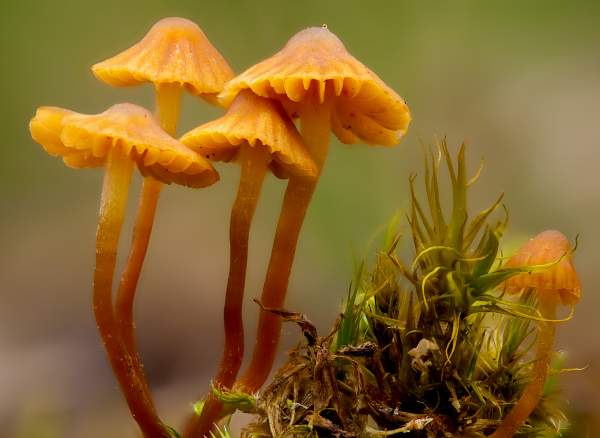
Galerina pumila with its widely-spaced gills and tiny orange caps, is an uncommon but welcome sight in wet mossy places. This is one of a small group of bright orange Galerina species, most of which seem unable to survive without mosses.
Identifying with certainty the many small Galerina and Mycena mushrooms that appear on mossy bogs, damp lawns and wet woodland edges requires microscopic examination (preferably assisted by chemical testing!).
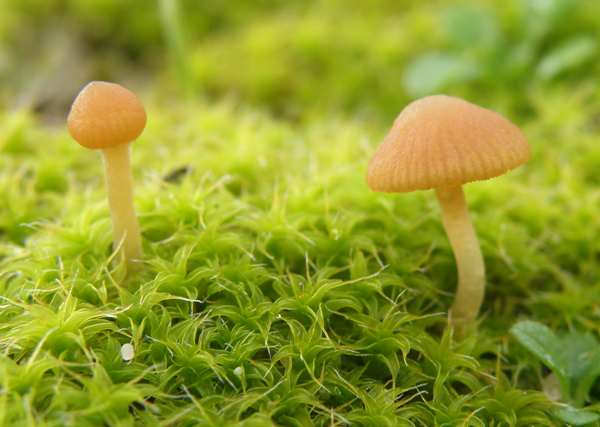
Distribution
Dwarf Bell Galerina pumila is uncommon in Britain and Ireland where it occurs on sphagnum mosses mainly in acidic boggy areas such as pond margins and peat bogs. This species is also recorded throughout most of central and northern mainland Europe.
Taxonomic history
This little mushrooms was described in 1801 by Christiaan Hendrik Persoon, who called it Agaricus pumilus. (In the early days of fungal taxonomy most gilled fungi were initially placed in a giant Agaricus genus, now largely redistributed across many other genera.)
It was the German-born American mycologist Rolf Singer who in 1961 transferred this species to the genus Galerina, thereby establishing its currently-accepted scientific name Galerina pumila.
Synonyms of Galerina pumila include Agaricus pumilus Pers., Agaricus mycenopsis Fr., Galera mycenopsis (Fr.) Quél., Pholiota pumila (Pers.) Gillet, and Galerina mycenopsis (Fr.) Kühner.
Etymology
Galerina, the generic name, means 'like a helmet', while the specific epithet pumila means dwarf or low growing.
Toxicity
Galerina pumila is inedible or suspect. In view of the fact that other fungi in this genus are known to be toxic toadstools - for example Galerina marginata contains deadly poisonous amatoxins which are the same kinds of substances that make Amanita phalloides, the Death Cap, so dangerous - this species should not be collected for eating. It is unlikely that anyone would want to hunt for such insubstantial and uncommon little fungi for food, but they could easily be gathered by mistake when collecting Marasmius oreades (Fairy Ring Champignons) which often grow in mossy grasslands. This further emphasises the importance of checking every single specimen that is gathered to eat.
Identification guide
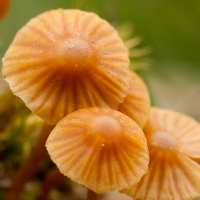 |
Cap
Initially conoical umbonate, expanding to become convex umbonate, striate almost to the centre; rusty brown, paler yellow-brown at the margin; 8 to 20mm diameter when fully expanded. White veil fragments sometimes visible at the margins of immature caps. |
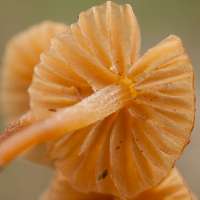 |
Gills
Moderately to widely spaced; pale yellow, becoming rusty yellow-brown.
Stem
1 to 3mm in diameter and 2 to 8cm
tall; cylindrical and hollow, yellow-brown; slightly rough due to attached veil fragmants, especially near the top of the stem; no stem ring. |
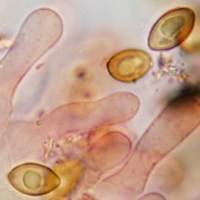 |
Basidia
Four-spored.
Cheilocystidia
Sub-cylindrical (long and narrow) often flexuose, with variably inflated tips. |
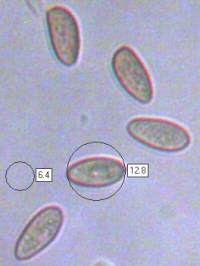 |
Spores
Ellipsoidal to amygdaloid (almond shaped), almost perfectly smooth, 10-13.5 x 5-7μm.
Spore print
Fulvous to pale ochre-beige. |
Odour/taste |
Not significant. |
Habitat & Ecological role |
In small groups or singly, often among lichens; growing on bryophytes including mosses of the genera Hylocomium, Dicranum, Ptilidium, Polytrichum and Racomitrium, in acidic woodlands, heathland and mossy grassland. |
Season |
Autumn. |
Similar species |
Kuehneromyces mutabilis, a much larger mushroom, is similar in colour range but has a pale cap centre and a darker margin; it does not grow on bryophytes but is confined to mainly hardwood substrates. |
Reference Sources
Fascinated by Fungi, 2nd Edition, Pat O'Reilly 2016, reprinted by Coch-y-bonddu Books in 2022.
Dictionary of the Fungi; Paul M. Kirk, Paul F. Cannon, David W. Minter and J. A. Stalpers; CABI, 2008
Taxonomic history and synonym information on these pages is drawn from many sources but in particular from the British Mycological Society's GB Checklist of Fungi.
Acknowledgements
Several of the pictures on this page are shown with the kind permission of David Kelly.
Top of page...
Fascinated by Fungi. Back by popular demand, Pat O'Reilly's best-selling 450-page hardback book is available now. The latest second edition was republished with a sparkling new cover design in September 2022 by Coch-y-Bonddu Books. Full details and copies are available from the publisher's online bookshop...